
Field Study of
Economics Department
経済学科のフィールドスタディ
2015 Report on the Field Study A in Hawai’i
Report from Professor : Makiko Omura
2015 Field Study A: Environmental Issues in Hawai’i
Field Study Experiences Leading to Active Learning
We conducted a field study (FS) in Hawai’i after three years since our last FS there.
While our group was relatively small this time with five male and two female students, we could have a fruitful FS with significant contribution from the lecturers, researchers, public officers and volunteers, who have been contributing to our programme.
The students took an intensive English language course for three days first, then joined various lectures and activities. In Kalaeloa Heritage Park, we learnt a Hawaiian history which integrated Tahitian culture, and took a part in the native species conservation activity there despite bad weather. The following day, we had an environmental economics lecture, the only lecture in Japanese, in the morning, then a field visit to Lyon Arboretum in the afternoon, where we learnt the ecological situation and conservation activities in Hawai’i. On Saturday, we visited Hanauma Bay where the state and local government, university organisation and volunteers were together executing a difficult task of balancing tourism and environmental protection. We learnt about their activities and could see the actual situation of the Bay by snorkelling. The following week, we visited the Hawai’i Institute of Marine Biology where we were explained about various sorts of research and activities they were conducting in order to understand the marine ecosystem much of which was yet left unknown. We also took part in sorting out native animals from invasive algae collected form Kaneohe Bay and recoding their quantities, as well as in a lab activity distinguishing different planktons and making their sketch looking into microscopes. This was a good hands-on experience which made us understand that environmental protection was done through cumulative daily efforts by many people. In the afternoon of the same day, we had two interesting lectures on terrestrial issues and climate change, which made us reconsider the way we live and the way economics conceptualise different phenomena. The following day, we made our first visit to the Kahuku Windfarm. This visit was planned three years ago but had to be cancelled due to a fire occurred at the plant. There, we learnt about the energy policies and power generation issues in Hawai’i, as well as the company’s future plans to overcome the necessarily fluctuating power generation, the process of negotiating with local habitants, the official system to decide on the electricity price, the future of electricity generation policy, etc. On our last day of activity, we had three very informative lectures, on Hawaiian energy policy, coastal hazards generated by climate change and sea level rise, and prevention and counter policy to mitigate the problems of invasive alien species.
It would be fantastic if the students not only gained new knowledge but also felt the blessings from the priceless nature for real through these in-depth lectures and activities, so that they would become active thinker about environmental issues. In order to be a responsible and active member of a society, it is necessary to transform a passive customer-like attitude, often seen among recent students, to a more proactive one, and I believe that this FS offered them a precious opportunity to realise that. I look forward to see such transformation in them. Lastly, I wish to convey my sincere gratitude to those who made this wonderful FSA possible.
Programme Schedule
Programme : 2015/8/30 – 9/12
| 8/30(SUN) | AM |
23:40 leave Haneda(JL080: 7h35) 12:15 arrive Honolulu |
| PM |
14:00 arrive Hotel Transportation & Town Orientation |
|
| 8/31(MON) | AM |
09:00-10:00 Campus Tour 10:00-12:00 English Class |
| PM | 13:00-17:00 English Class | |
| 9/1(TUE) | AM | 09:00-12:00 Language Exchange |
| PM | 13:00-17:00 English Class | |
| 9/2(WED) | AM | 09:00-12:00 Language Exchange |
| PM | 13:00-17:00 English Class | |
| 9/3(THU) | AM PM |
08:15 leave Hotel
09:30-13:30 Field1 & LEC1 14:00-15:00 White Plain Beachpark 16:15 arrive Hotel |
| 9/4(FRI) | AM |
09:00-10:30 LEC2 Nori Tarui “Economics of Climate Change”(in Japanese) 10:45-12:15 LEC3 |
| PM |
13:15 leave UoH
13:30-16:00 Field2 & LEC4 16:30 arrive Hotel |
|
| 9/5(SAT) | AM PM |
08:00 leave Hotel
09:30-14:30 Field3 & LEC5 15:45 arrive Hotel |
| 9/6(SUN) | ALL | Free time |
| 9/7(MON) Holiday |
ALL | Free time 20:00-21:00 Mid-term Report Meeting |
| 9/8(TUE) | AM |
08:00 leave Hotel 09:00 arrive @ Lilipuna Pier 09:00-9:15 boat 09:15-11:45 Field4 & LEC6 12:00 leave Pier |
| PM |
14:00-15:30 LEC7 Cliff Morden “Terrestrial Issue 15:45-17:15 LEC8 |
|
| 9/9(WED) | AM PM |
08:00 leave Hotel
09:30-11:30 Field5 & LEC9 12:00-12:20 Turtle Crossing 12:40-15:00 Haleiwa Town 16:30 arrive Hotel |
| 9/10(THU) | AM |
9:15-10:45 LEC10 Makena Coffman “Planning for Greenhouse Gas Mitigation in Hawaii” 11:00-12:30 LEC11 |
| PM | Dinner | |
| 9/11(FRI) | AM | Free time |
| PM |
15:10 leave Hotel Final Report Meeting @ airport 18:50 leave Honolulu (JL089:8h10) |
|
| 9/12(SAT) | PM | 22:00 Arrive Haneda |
Student Reports
Photos
-
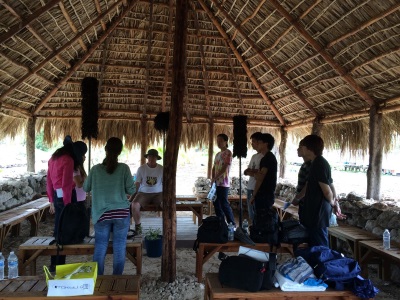
Students receiving instruction about the conservation activity from Bruce in Kalaeloa Heritage Park. -

The blue flags point the location which the students planted native species. They were then cutting down an invasive tree at the back. -
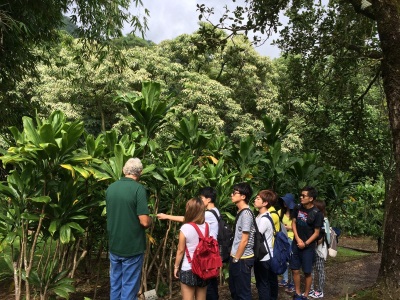
Students receiving explanation about different native species from Carl at the Lyon Arboretum. -
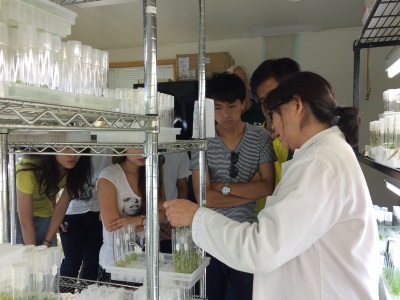
Nelly explaining about tissue culture done in the lab at the Lyon Arboretum. -
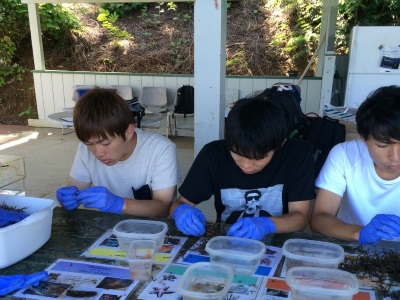
Selecting native animals out from invasive alien algae and recording their units at the HIMB. -

Identifying types of planktons collected in Kaneohe Bay through microscopes and sketching them. -
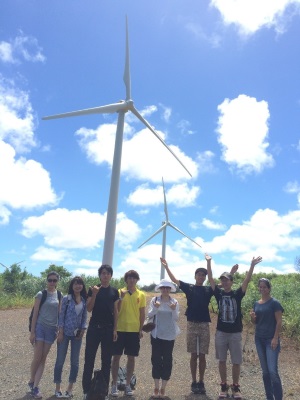
At the first wind power station in Oahu. -
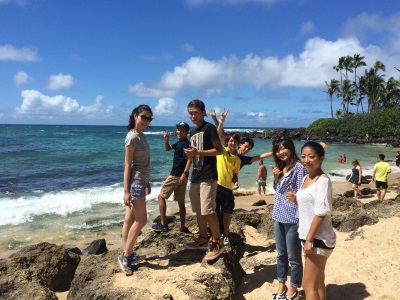
At the Turtles Crossing where we could see many turtles floating.